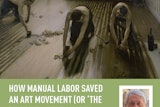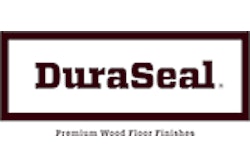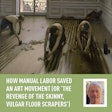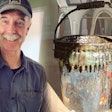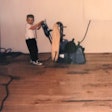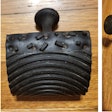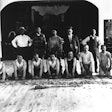 At this meeting in St. Louis in December 1985, the National Wood Flooring Association was officially created. Seen are (seated, left to right): Jack Wilcox, H.G. Roane Company; Ralph Singer, Diamond W Supply; Lon Musolf, Lon Musolf Distributing; Roland Holder, Gentry & Holder Floors; Harold Reid, Trinity Floor Company; (standing, left to right): Gary Reynolds, Galleher Hardwoods; Steve Brown, Swift-Brown Distributors; Art Pedicini, Geysir Sales Corporation; Jack Coates, Golden State Flooring; Richard Steeneck, Hoboken Wood Floors; Virgil Hendricks, Mid-West Floor Company; Eldon Robbins, Mid-West Floor Company; and Keijo Hyvonen, Kelly-Goodwin Company.
At this meeting in St. Louis in December 1985, the National Wood Flooring Association was officially created. Seen are (seated, left to right): Jack Wilcox, H.G. Roane Company; Ralph Singer, Diamond W Supply; Lon Musolf, Lon Musolf Distributing; Roland Holder, Gentry & Holder Floors; Harold Reid, Trinity Floor Company; (standing, left to right): Gary Reynolds, Galleher Hardwoods; Steve Brown, Swift-Brown Distributors; Art Pedicini, Geysir Sales Corporation; Jack Coates, Golden State Flooring; Richard Steeneck, Hoboken Wood Floors; Virgil Hendricks, Mid-West Floor Company; Eldon Robbins, Mid-West Floor Company; and Keijo Hyvonen, Kelly-Goodwin Company.
 NWFA CEO/President Michael Martin takes the floor during the 2014 Wood Flooring Expo in Nashville, Tenn. - Click to enlarge
NWFA CEO/President Michael Martin takes the floor during the 2014 Wood Flooring Expo in Nashville, Tenn. - Click to enlarge
As the NWFA celebrates three decades as the association serving the entire wood flooring industry, HF sat down to speak with NWFA CEO/President Michael Martin. Martin took the reins of the NWFA in the spring of 2011 and has overseen the NWFA during a time of significant challenge and change as the industry emerged from the Great Recession. HF spoke with Martin at the close of 2014 to reflect on where the association has been, and what its purpose should be as the industry looks ahead to another 30 years.
HF: How is the NWFA different than other associations you're been involved in?
1985
|
1986
|
1987
|
1988
Click here to flip through a digital version of the first issue of HF. The NWFA moves its headquarters out of Mid-West Floor Co. to offices on Manchester Road in St. Louis. |
1989
|
|
|
1990
|
|
|
1991
|
|
Click here to view the digital version of this The Log newsletter. |
|
NWFA moves into larger offices in Manchester, Mo. |
1992
|
1993
|
|
|
1994
|
|
|
|
Ed Korczak hired as executive director. |
1995
|
|
|
1996
|
|
|
1997
|
|
|
1998
|
1999
|
|
|
|
|
2000
|
2001
|
|
|
2002
|
|
NWFA holds first factory-finished flooring school in Rockford, Ill. |
2003
|
|
|
2004The 50th NOFMA/NWFA/MFMA Professional Installation School held. |
2005
|
|
|
2006
|
2007
|
2008
|
|
|
2009
|
2010
|
2011
|
|
|
2012
|
2013
|
|
|
2014
|
|
NWFA is instrumental in creating the Floor Covering Leadership Council; the first meeting is held at the 2014 NWFA Expo in Nashville. |
2015
|
MM: The NWFA is different in the fact that it represents the entire supply chain, whereas many associations represent a single constituent. Having the manufacturers, distributors, contractors, dealers, retailers, inspectors, and installers in one association is NWFA's greatest strength. Every type of company that is engaged in the business of wood flooring has a voice in decisions. We are truly addressing industry issues collectively, as opposed to looking at the world through one special interest group's lens.
HF: Many people feel that the NWFA is much more than just an association for them. What is it about the NWFA that makes people feel that way?
MM: For a lot of people NWFA is a big part of their business. For manufacturers, it's a part of how they go to market with new products through Expo and advertising, educate customers and participate in industry standards. For distributors, NWFA provides training partnerships for customers as well as employees. For contractors and inspectors, the technical training and guidelines are used every day in the workplace.
But, most importantly, personal relationships with peers and business partners are created through participation in NWFA. Where else could contractors meet and get to know the people who are making and selling the products they use on a daily basis besides NWFA? The feedback shared between member types is invaluable in creating the overall success of the wood flooring industry from product development through installation.
HF: What are the most important roles that NWFA plays for the industry?
MM: Expo and the magazine are very important networking, education and communication tools, but the technical education NWFA provides is extremely important to the health of the overall industry. The industry guidelines and publications create a common ground for the entire industry to work from, with the common objective of consumer satisfaction through successful installation. Everybody wins with good installations, and profitability goes up exponentially, creating a better industry for everyone in it.
HF: Are there things that the NWFA does on a daily basis you think people aren't really aware of?
MM: I think one of the things that people aren't aware of is how many calls we field to help contractors who are on a job site, or from consumers who have questions. We have technical experts dedicated to answering calls all day. That's part of our service to our members—if they have a question and we don't have an answer, we will find one. Something our members may not know is that through these calls and the 250,000 visitors we serve through woodfloors.org each year, we help a lot of consumers find and hire local members in their area.
Advocacy is another function that's a little removed from our member's daily interaction with us. There are many efforts on an ongoing basis to protect NWFA members from unnecessary environmental and business regulations that could paralyze member businesses. Sometimes people question where their dues dollars go; I think the advocacy efforts alone that we're working on with the Hardwood Federation and other alliances in D.C. are well worth the investment in NWFA. No one else is looking out specifically for the wood flooring guy.
HF: How has the market shifted over the last 30 years?
MM: When the NWFA started, most installations were on-site sand-and-finish jobs, whereas more than half of the wood flooring going in homes today is factory-finished. That's a huge change, and one that impacts the market's landscape on an ongoing basis. The wood flooring market used to be much smaller, and more defined, with fewer sellers and fewer installers who tended to specialize in wood. Today, big boxes, carpet stores and full-line distributors are selling and installing wood flooring because they don't have to sell and install an unfinished product that needs an on-site finish expert.
The Great Recession in particular caused this market fragmentation to move faster, as nearly all companies were looking for new ways to supplement their revenues by adding new lines or new installation services. Many non-traditional flooring companies added wood flooring or other lines to their product offering or installation services to stay in business and be competitive.
We recently did a survey that showed that most of our NWFA member contractors are doing multiples surfaces, typically all hard surfaces, and it was really surprising to me. I think if you would have done that survey 30 years ago you would have found that most members were just doing hardwood flooring, period.
HF: How has the international nature of today changed the NWFA?
MM: A big market driver that's changed over the years is the amount of product that is produced or sold overseas. That's something that didn't happen the same way 30 years ago when NWFA's membership was primarily focused on the U.S. market. The market has shifted to a global supply chain, and clearly we have to serve the market. So if half of the product sold in the U.S. is coming from overseas and half of U.S. products are going to overseas consumers, the NWFA has to have an international presence and help facilitate that business.
Today we have members in 46 countries. We participate in several international shows on an annual basis to foster those relationships. We also have a fairly large international component that attends our Expo annually.
HF: How has the NWFA changed in recent years?
MM: NWFA is unique in that we exist in two different industries that really have nothing to do with one another other than that the raw materials from the hardwood industry eventually become flooring. One of the biggest changes in recent years is the expansion of NWFA as a leader in related industries.
In the flooring industry, NWFA has worked to help create the Floor Covering Leadership Council, which brings all the associations that are part of the floor covering industry together. With the growing fragmentation of the wood flooring market, it makes it all the more necessary for us to be the voice of wood flooring throughout the flooring market.
In the hardwood industry, working with the Hardwood Federation, environmental groups, lumber and manufacturer groups helps us protect and promote wood flooring as a viable, environmentally friendly product.
Getting out of our "NWFA silo," and working with the other groups helps make our future more secure. We have to be the voice of wood flooring for our members, from the world of design to retail to architecture. The biggest shift is that we have tried to be much more externally focused in the marketplace, and less focused on our own piece of the world.
HF: Can you explain the different entities that are included under the NWFA umbrella?
MM: Our strategic plan between 2012 and 2015 included the restructure of the governance model of the NWFA boards and committees, which resulted in the blending of some activities and committees, and the moving of all education functions from NWFA and NWFACP to the Foundation for the purpose of streamlining the scholarship programs, providing funding for students who need training but might not be able to afford to attend on their own.
The original association was established and continues to function as a 501(c)(6) not-for-profit entity. The second entity created was the NWFA Research Foundation, which was recently renamed the NWFA Education & Research Foundation (NERF) and now operates as a charitable 510(c)(3) organization. The third entity is the NWFA Certified Professionals, which is a separate 501(c)(6) not-for-profit that houses our four certifications: Installer, Sand & Finish, Inspector and Sales Advisor.
HF: What other priorities were in the 2012 strategic plan?
MM: The biggest priority was financial recovery caused by the recession. That has been achieved—we are well-positioned for the future. Our other priority was to review all the programs and services being offered. We have added some programs, have completely redone the technical education components of the association, and the Expo has been completely re-launched in a new format—all our top products and services have been realigned to match the current market. Everything we set out to do in 2012 by 2015 was accomplished by mid-2014, so the NWFA board of directors is now working on a new five-year strategic plan set to launch in late 2015 that would take us through the year 2020; we are calling that plan Vision 2020.
HF: Can you tell us exactly what Vision 2020 entails?
MM: Officially, the process will launch with a survey before Expo. Then, during Expo we'll have a consultant present the findings to all of our boards at a first-ever joint board meeting of the NWFA, NWFA Education & Research Foundation, and NWFA Certified Professionals. Following the board discussion, we'll host a Vision 2020 session at Expo that anyone can participate in that really talks about what the NWFA needs to be doing over the next five years to make a difference in the marketplace. We'll identify what the needs are we should focus on, because it really is up to our board and our members to provide us with that information; then we implement those objectives that are defined by the marketplace.
HF: How does a member get involved in that?
MM: Members can send in the survey, they can call us with feedback or they can come to the session at Expo and participate in person. After Expo the staff will come back and put together a strategic plan to present to the board next fall based on all of that input. Then the plan will be published in the fall so all the membership will have an opportunity to see what those priorities are for the next five years and see how they fit in that plan.
HF: What do you think might be the strongest themes that come from membership in the Vision 2020 process?
MM: I don't know whether the process will reveal what we see as the biggest challenge right now or not, but we currently see the biggest challenge at the point of sale—either the consumer or the person selling the flooring doesn't understand how to choose the right product for the right application. So oftentimes when we see inspections or have consumer calls, we're usually discovering that the whole problem would have been avoided if the right product had been specified for the right conditions. How do we effect change at the point of purchase? Change can only come by creating consumer awareness and education at the retail sales level.
HF: Given that, what changes are happening with training going forward?
MM: We have added an education staff position that will begin to integrate new online training with our hands-on training. We will then work toward creating a clear career path through installation or sales. Right now between NWFA certifications, certificates of completion and degrees, there is some confusion about what those designations mean in the marketplace. We're going to streamline that so it's really simple for the industry to understand what being NWFA-certified or degreed means. Ultimately, those designations should also resonate with the consumer, providing a competitive advantage to NWFA certified or degreed members.
We're also talking with other associations about having a centralized training facility that handles all flooring types, where we would be the wood flooring training provider. This could help us identify future wood flooring installers as they come through multiple disciplines. And, collectively, one of the biggest challenges we face is really a shortage of installers. That's not just a wood flooring issue, that's an issue across all sectors of the flooring industry.
NWFA Hall of FameOver three decades, only 16 people have been chosen to be inducted into this select group. To be in the Hall of Fame, people must have demonstrated significant innovation, service and/or leadership within the wood flooring industry; a minimum of seven years of service within the wood flooring industry; demonstrated professionalism, ethics and integrity; and unanimous approval by NWFA's executive committee and board of directors. Here they are, in order of their Hall of Fame induction. |
|
|
Allen Harris Jr.
Allen Harris Jr., the first inductee to the NWFA Hall of Fame, at the NWFA convention in Dallas in 1989, was born in Johnson City in 1906. He went into the family business, Harris Manufacturing, after graduating from college in 1929. And in 1968, he succeeded his father as president of the company. Harris served as president of the National Oak Manufacturers Association, Maple Flooring Manufacturers Association and the Lumber Trade Association. He was vice chairman of Harris-Tarkett until he passed away in 1992. |
Virgil Hendricks
Virgil Hendricks is considered the founding father of the NWFA and served as its first president. He was inducted into the NWFA Hall of Fame in 1990. He founded Mid-West Floor Co. and Lockwood Flooring—the first NWFA member company—and Hendricks volunteered space at Mid-West along with the services of his employee Bonnie Holmes to run the NWFA in its early years. "It was a lot of fun, and I had more fun than anybody ... and to think that things started right here in my office," Hendricks told HF in a 2010 interview about the early days of NWFA. He passed away in 2011 at the age of 93. |
|
Johnny Austin
Johnny Austin was one of the original eight founders of the NWFA who donated their own money to launch the NWFA. Austin was considered "a good old boy and a gentleman and a wood man" according to Bonnie Holmes, the first NWFA employee. Austin owned A.J. King Lumber Company in Sevierville, Tenn. He was one of seven founders to be inducted into the NWFA Hall of Fame at the NWFA convention in Dallas in 1994. Austin passed away in 1996. |
Jack Coates
Jack Coates was one of the eleven men who met in Dallas in July 1985 to discuss the idea of a trade association to bring the industry together. He, along with his brother Dick Coates, was a fixture at Golden State Flooring (S. San Francisco), founded by his father Clifford in 1926, for more than 50 years, and he rose to become vice president of Golden State parent company J.E. Higgins. He was inducted into the Hall of Fame during the 1994 NWFA convention and retired two years later. Coates passed away on Jan. 2 of this year. |
|
Albert Duke
Albert Duke started working for Peace Flooring Co. (Magnolia, Ark.) in 1950, and after much hard work became the company owner 26 years later, in 1976. He held the position until he sold it to his son, Steve Duke, upon retiring in 1989. Albert Duke was one of the original 11 founders of the NWFA and was inducted to the NWFA Hall of Fame in 2004. He told a researcher from Southern Arkansas University that he enjoyed his job his whole life: "I never have dreaded going to a job. I always was anxious to get to it." He passed away in 2003. |
Roland Holder
"The only shortcut you take in the flooring business is the route to the job site," is what an attendee at a NOFMA training in 1981 remembers hearing from instructor Roland Holder, regarded as one of the most influential instructors in the early years of the NOFMA school, where he taught from 1979 until 1990. Holder was in the flooring industry for 59 years. He started at the age of 15, working part-time after school, and founded his contracting business Gentry & Holder Floors in 1958. Holder was inducted to the NWFA Hall of Fame in 1994 along with six other original founders of NWFA. |
|
Harold Reid
Harold Reid, one of the NWFA founding fathers, led Dallas-based installation firm Trinity Floor Company. Reid started at the company in 1937 as an installer, earning 45 cents an hour. He was actively involved in multiple flooring associations; he founded the North Texas Flooring Association, was at one time the longest-standing associate member of MFMA, and also served as president of the Dallas Floor Covering Association. Additionally he is remembered fondly as a key instructor, along with his friend Roland Holder, at the NOFMA School. He was inducted into the NWFA Hall of Fame with fellow NWFA founders in 1994. He passed away in 2012 at the age of 95. |
Gary Reynolds
Gary Reynolds began working in the hardwood flooring industry after he was discharged from the Army in 1959. His first job was with a division of Servicemaster. From there he went from DuraSeal to Galleher before opening a U.S. subsidiary of the Swedish BonaKemi, now known as Bona US. He retired more than once, and his final retirement in 2014 followed a six-year consulting job with UFloor Systems. Reynolds passed away shortly thereafter. He was an NWFA founding father and served on the NWFA board of directors from 1986–1990. Reynolds was among the original NWFA founders inducted into the NWFA Hall of Fame in 1994. |
|
Jack Wilcox
Jack Wilcox followed his friend Virgil Hendricks to become the second president of the NWFA. Wilcox acquired ownership of the Roane Company from his father, Hartwell Roane, in 1963. The Roane Company underwent significant growth and eventually distributed vinyl, ceramic, rubber, carpet and laminate flooring, in addition to hardwood flooring. Wilcox was awarded a Silver Trumpet Award from the Southern California Floor Covering Club. He was one of the eight men who put up seed money to get the association off the ground. At the NWFA Convention in 1994, Wilcox was inducted with fellow founders into the NWFA Hall of Fame. |
Bill "Mac" McLaughlin
Bill "Mac" McLaughlin worked for Powernail for 34 years, covering a sales territory that ran from South Carolina to Delaware. He was also a fixture for years as an instructor at industry training events, including the NOFMA school in Memphis and the various NWFA regional and national training schools. McLaughlin passed away in 1997. His son, Richard, also a sales representative for Powernail, accepted the NWFA Hall of Fame award on his father's behalf in 2000. When McLaughlin retired in December 1995, he said: "All the friends and people I call on are like family to me. I have more than 500 stops, and there's not one guy I don't know on a first-name basis. But it's time to move on." |
|
Lon Musolf
Lon Musolf started in the wood flooring industry as an apprentice installer in 1947. Using his savings, all of $300, he founded the Lon Musolf Flooring Company in 1953. He sold the company in 1986 to start a new venture, Lon Musolf Distributing, at one time one of the largest wood flooring distributors in the Midwest. He retired after nearly 50 years in the industry in 1996. He was inducted into the Hall of Fame in 2001. Lon is known for a favorite motto, "If you haven't time to do it right, when will you have time to do it over?" |
Ralph Singer
Ralph Singer Jr. was president of Diamond W Supply Co. from 1963 until 1997, when he remained as chairman of the board and CEO. In 2006, Singer entered into an agreement with North America Holding Company to sell Diamond W Supply to Tarkett. He retired two years later. Singer was extensively involved with NWFA, serving as its president from 1992–1993. He was inducted into the NWFA Hall of Fame in 2001. |
|
Claude Taylor
Claude Taylor started in the wood flooring industry in 1949, working in the mail room at the E.L. Bruce Company, forerunner to Bruce Hardwoods. He retired in 1995 as Memphis Hardwood Flooring's sales and marketing director. Upon retiring he said, "I accidentally picked a career and an industry where you can still do business with a handshake. It's a most honorable field. I've made some great friendships, and that's what I'll miss most," Taylor served two terms as NOFMA president and six years on the NWFA board of directors. He was inducted into the Hall of Fame in 2003 and passed away in 2010. |
Edgar & Carl Anstett
Brothers Ed (top) and Carl Anstett (bottom) immigrated to America in 1925 and 1930, respectively. They formed a tool and die business in the families' garage near Wrigley Field in Chicago in 1939. After a brief interruption (WWII) the brothers co-designed the Powernail Powercleat and the Model 45 Powernailer. The inventions brought a paradigm shift to the wood flooring installation industry. They moved operations to Prairie View, Ill., and founded the Powernail Company Inc. Ed passed away in 2001 and Carl followed in 2005. They were inducted into the NWFA Hall of Fame in 2007. |
|
Eugen Lägler
Eugen Lägler, a German machinist, saw how the drum sander frustrated wood flooring professionals—inserting new sandpaper was harder than it needed to be, and the machine could leave chatter marks. He decided to engineer a belt sander, which was then only used in large-scale industrial applications, for use on the job site. It worked, wood floor sanding underwent a revolution and now the Lägler company is a worldwide business. He was inducted into the NWFA Hall of Fame in 2008 after passing away in 2007. |
|





































































